Planning and laying out the vegetable garden is an important step in starting a successful garden.
To layout an effective vegetable garden you need to do a few things.
- Pay attention to the Sun’s movement
- Be realistic about the space you are working with
- Decide what you want to plant and eventually eat
- Plan it out
- Think in Layers
- Take advantage of harvest times
Observe the sun
Pay attention to how the sun moves. I was amazed at how much differently the sun hit my garden from summer to winter.
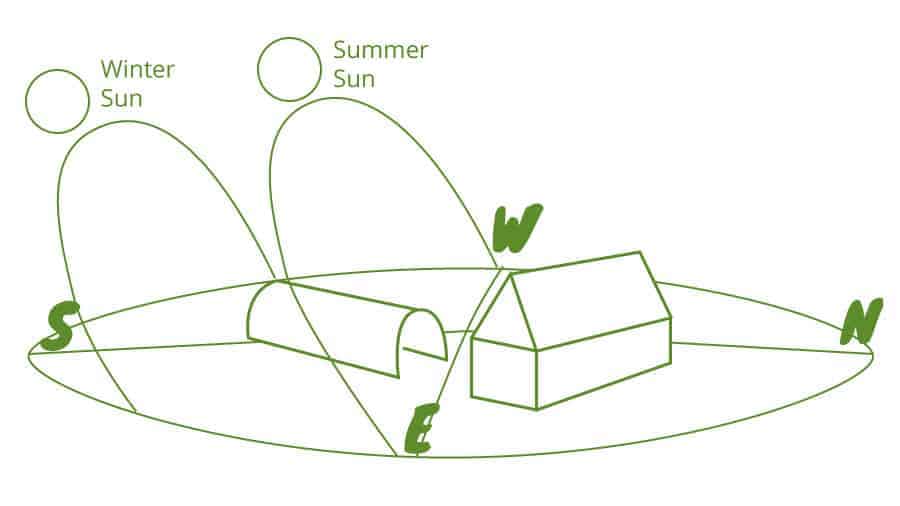
It’s crazy when you think about it. we are on a floating rock tilting slightly closer and further away from a flaming ball. that’s what causes our weather to change.
As we tilt closer to the sun it obviously gets hotter, the sun also moves in a northern direction in the sky.
The summer solstice, which is the longest day of the year also marks the sun’s most northern point in the sky. It will slowly move in a southern direction after that day. Until the winter solstice, which is the shortest day of the year. At that point, the sun starts to move in a northern direction again.
Generally speaking, the south side of your home will receive the most sunlight.
This is going to vary of course. If you have a giant oak tree in your south facing yard you won’t be getting a whole lot of sunlight obviously.
Also, generally speaking, orienting your gardens from north to south will provide the entire garden more even amounts of sunlight.
So, pay attention to your yard, balcony or patio and see how much sunlight each area gets.
This is your initial step in designing your garden.
How much space do you have that gets good sun.
Some people may have only a corner of a balcony, but that’s fine.
You can still grow a few plants and scratch that gardening itch.
Plant spacing
Whenever you get seeds, take a look at the packet, it should give you space requirements.
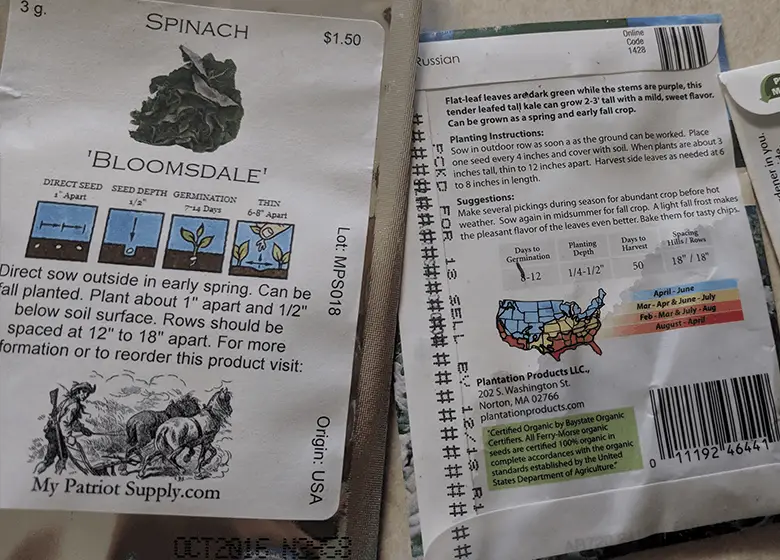
Usually plant spacing and row spacing.
When you see the term plant spacing, this means how far away one seed is from another.
For instance, most tomatoes need about 36” of space from each other while spinach only requires 6”.
Row spacing is simply the distance between rows.
Use this as a guideline, but always double check your seed packet.
Arugula:
- Plant: 3-4”
- Row: 10”
Bush beans
- Plant: 2-4”
- Row: 18”
Beets
- Plant: 2-4”
- Row: 12”
Broccoli
- Plant: 10-15”
- Row: 24”
Brussels sprouts
- Plant: 18-24”
- Row: 24”
Cabbage
- Plant: 9-16”
- Row: 24”
Carrots
- Plant: 1-3”
- Row: 10”
Cauliflower
- Plant: 12-18”
- Row: 24”
Celery
- Plant: 6-12”
- Row: 18”
Collards
- Plant: 12-24”
- Row: 24”
Corn
- Plant: 6-8”
- Row: 28”
Cucumbers
- Plant: 6-12”
- Row: 48”
Eggplant
- Plant: 18-40”
- Row: 36”
Kale
- Plant: 8-12”
- Row: 18”
Lettuce
- Plant: 8-12”
- Row: 18”
Lima beans
- Plant: 3-6”
- Row: 18”
Mustard
- Plant: 5-10”
- Row: 12”
Okra
- Plant: 4-10”
- Row: 36”
Onions
- Plant: 2-6”
- Row: 14”
Peas
- Plant: 2-6”
- Row: 12”
Peppers
- Plant: 9-15”
- Row: 15”
Pole beans
- Plant: 3-5”
- Row: 36”
Potatoes
- Plant: 5-10”
- Row: 36”
Pumpkin
- Plant: 36-60”
- Row: 60”
Radish
- Plant: 1”
- Row: 6”
Spinach
- Plant: 2-6”
- Row: 12”
Squash(Summer)
- Plant: 12-24”
- Row: 36”
Squash(Winter)
- Plant: 36-60”
- Row: 60”
Strawberry
- Plant: 12-16”
- Row: 12”
Swiss chard
- Plant: 6-12”
- Row: 18”
Tomato
- Plant: 18-32”
- Row: 48”
Turnips
- Plant: 2-6”
- Row: 12”
Watermelon
- Plant: 24-48”
- Row: 60”
These numbers also don’t have to be followed to a T.
I’ve found some plants, like an Everglades tomato, to grow wild. Needing much more space than the recommended 36”.
However, if you plan on pruning, you will probably be able to fit a lot more veggies in one space than the seed packets say.
Be realistic with your space
Don’t try to grow a monster squash plant in a 12” pot on your front patio. That just isn’t going to work out.
I’m so guilty of not being realistic with my space. I always want to plant more than what I actually have room for.
My first garden was a tiny 4’x 4’ raised bed and I think I seriously crammed a watermelon, two tomatoes, an eggplant and a handful of beans.
Needless to say, it didn’t turn out very well.
Plants like a tomato, eggplant, collard, and squash need about a three-foot area all the way around them to grow productively.
Smaller plants, like lots of lettuces, can be packed more tightly and still be productive.
Maximizing space is walking that fine line of planting the perfect amount of veggies.
Not too crowded but not too bare.
If you plant too many in one spot all of them will be weak, unproductive plants.
Instead of smashing 6 plants into one area, plant 3 and you will actually end up with more food.
Fewer plants with a healthy amount of space will produce more than 6 tightly cramped plants.
You can maximize your space by putting the second row slightly off center from the first row.
In a zig-zag like pattern
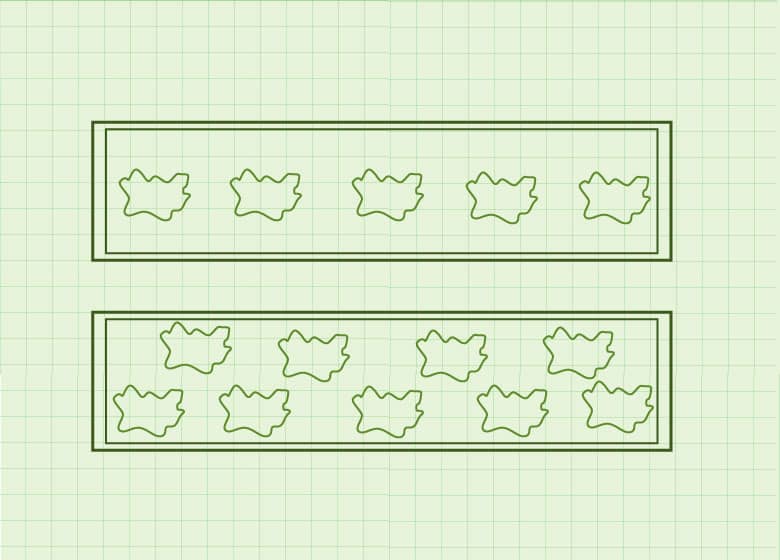
Think in Layers
I’ve found it super useful to think about how tall a plant will grow. For instance, a lettuce will only grow to about a foot or so tall. While a tomato will grow to several feet tall.
At first, when they are both tiny seedlings this won’t make a big deal.
But as the tomato continues to grow it can provide shade for the much smaller lettuce.
This may be a good thing, or it may be a bad thing.
For a lettuce, this might not be the end of the world.
However, for something like a bush bean, this would definitely cause a problem.
Lettuce doesn’t mind indirect sun as much as a bean does.
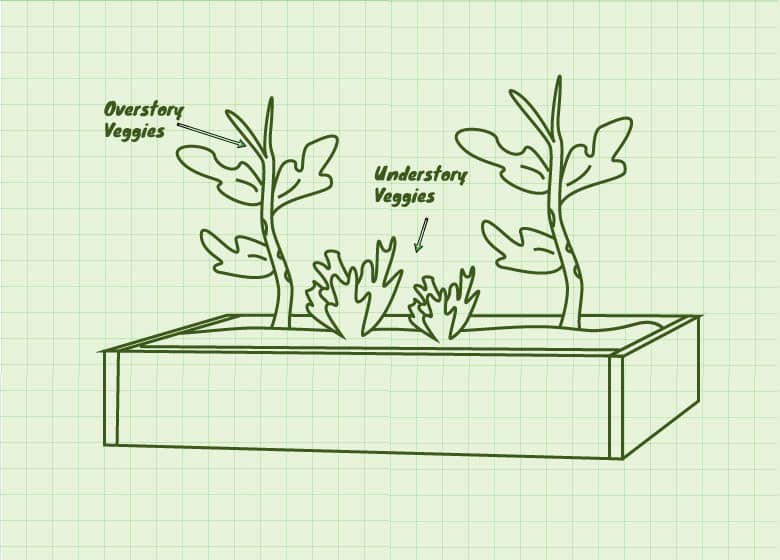
A common garden layout that we can take advantage of in Florida is called the three sisters guild.
This is when you plant corn, beans, and squash all together.
The corn grows tall for the beans to climb and the squash grows low and big to provide shade to the soil and help with water retention. These three plants work very well together.
Timing
You can also maximize your harvest by thinking in layers of time as well.
For instance, a full grown collard will take up a few feet of space. However, it’s going to take some time for it to reach that size. In the meantime, you can always plant a lot of fast-growing, smaller plants to fill that space up.
Things like lettuce, beets, and radishes.
Fast growing crops that you can harvest before your collard really requires more space.
A common pair of veggies that are planted together to maximize time and harvest is carrots and radishes.
Radishes mature quickly, usually around 50 days. The fast-growing radishes will provide shade for the carrot seedlings and will be ready for harvest before the carrots need that space. It’s a great way to maximize space by using harvest times in your favor.
It’s also best practice to spread out the planting of fast-growing veggies over a period of several weeks.
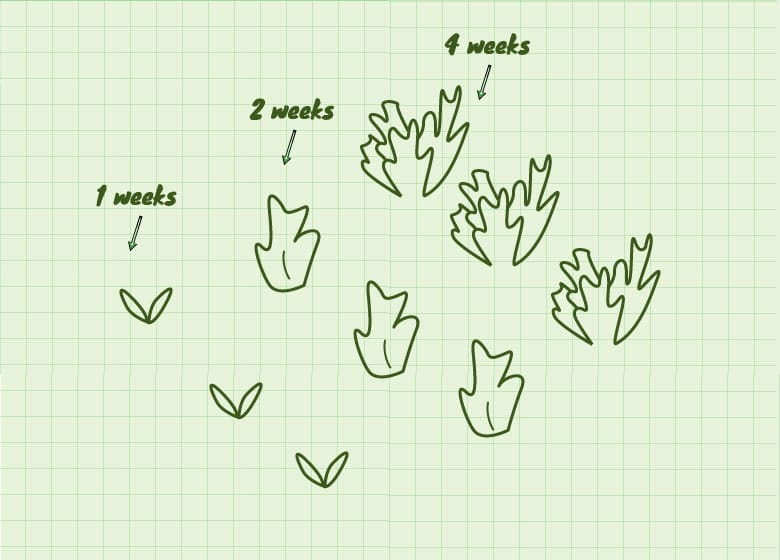
Plant what will actually be eaten.
This sounds pretty obvious but it’s still something I think should be stated. I’ve grown some veggies just to say that I’ve grown them. But it’s kind of an awful feeling when you can’t find anybody to take them off your hands and put them to good use.
You can also ways compost them so they aren’t a complete waste but it still kinda stinks.
Plan it out on paper
Your design doesn’t have to be anything fancy. Literally a rough sketch of what you are working with, just so that you can visualize and see how much space you are actually working with.
This also helps me think about how the different height of plants will affect each other with the sun’s movement.
There are a couple of online garden planners. You have to pay for some of them and others are free.
But honestly, I don’t see the point. Maybe I’m a little old school when it comes to gardening but I think pen and paper work just fine for the planning stage.
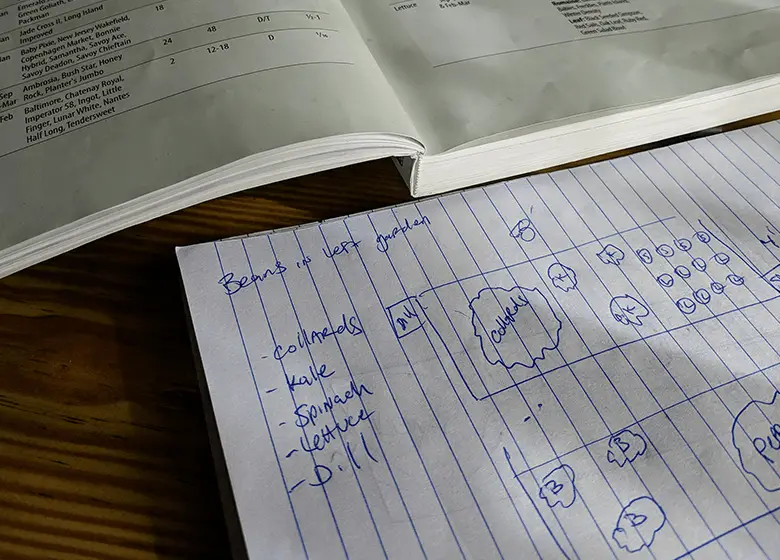
Popular veggies to grow in Florida
You can grow lots of things in Florida, We actually have two, very productive growing seasons.
I think anybody, in any part of the state, could grow any of these plants. All of the plants and varieties I recommend are also recommended by The University of Florida’s horticultural program as well as Robert Bowden, author of Florida fruit and Vegetable Gardening.
You might also find this article helpful : 27 of the easiest vegetables to grow in Florida
Beans
Florida friendly varieties:
- Bush: Bush Blue Lake, Contender, Roma II, Provider, Cherokee wax
- Pole: McCaslan, Kentucky Wonder, Blue Lake
Planting times:
- North: Jan – Dec Central: Jan – Dec South: Jan – Dec
Beets
Florida friendly varieties:
- Baby Ball, Tall Top, Early Wonder, Detroit Dark Red, Cylindra, Red Ace, Yellow Detroit
Planting times:
- North: Sep – Mar Central: Oct – Mar South: Oct – Mar
Broccoli
Florida friendly varieties:
- Early Green, Early Dividend, Green Sprouting, Waltham, Packman, De Cicco, Rapini
Planting times:
- North: Sep – Jan Central: Sep – Jan South: Sep – Jan
Collards
Florida friendly varieties:
- Georgia Southern, Morris Heading, Yates
Planting times:
- North: Jan – Dec Central: Jan – Dec South: Jan – Dec
Carrots
Florida friendly varieties:
- Baltimore, Chatenay Royal, Imperator, Nantes, Danvers
Planting times:
- North: Sep – Mar Central: Oct – Mar South: Oct – Feb
Okra
Florida friendly varieties:
- Clemson Spineless, Emerald, Annie Oakley II, Cajun Delight
Planting times:
- North: Mar – Jun Central: Feb – Aug South: Jan & Aug
Lettuce
Florida friendly varieties:
- Bibb: Ermosa, Bibb, tom Thumb, Buttercrunch
- Romaine: Parris Island cos, Outredgeous
- Leaf: Black seeded simpson, Salad Bowl, Red Sails, Oak Leaf
Planting times:
- North: Sep & Feb Central: Sep – Mar South: Sep – Jan
Peppers
Florida friendly varieties:
- Sweet: California Wonder(Bell), Red Knight, Big Bertha, Sweet banana, Giant Marconi, cubanelle
- Hot: Early Jalapeno, Cherry Bomb, Hungarian Hot Wax, Big Chille II, Thai, Anaheim Chile, Long Cayenne, Habanero
Planting times:
- North:Feb & Jul Central: Feb & July South: Aug – Sep
Raddish
Florida friendly varieties:
- Cherry Belle, White Icicile, Sparkler, Champion, Daikon
Planting times:
- North: Sep – Mar Central: Sep – Mar South: Oct – Mar
Spinach
Florida friendly varieties:
- Bloomsdale Long Standing, Walabar red Stem
Planting times:
- North: Sep – Mar Central: Sep – Mar South: Oct – Mar
Tomato
Florida friendly varieties
- Indeterminate (Large Fruit): Better Boy, Bonnie’s Best, Striped Cavern
- Indeterminate (Small Fruit): Everglades(summer friendly), Husky Cherry, Sweet 100(Summer friendly),
- Determinate(Large Fruit): Celebrity, Tasti-Lee
- Determinate(Small Fruit): Floragold
- Dwarf Varieties: Patio, Small Fry, Tiny Tim
Planting times:
- North: Feb & Aug Central: Mar & Aug South: Aug – Mar
Florida garden layout ideas
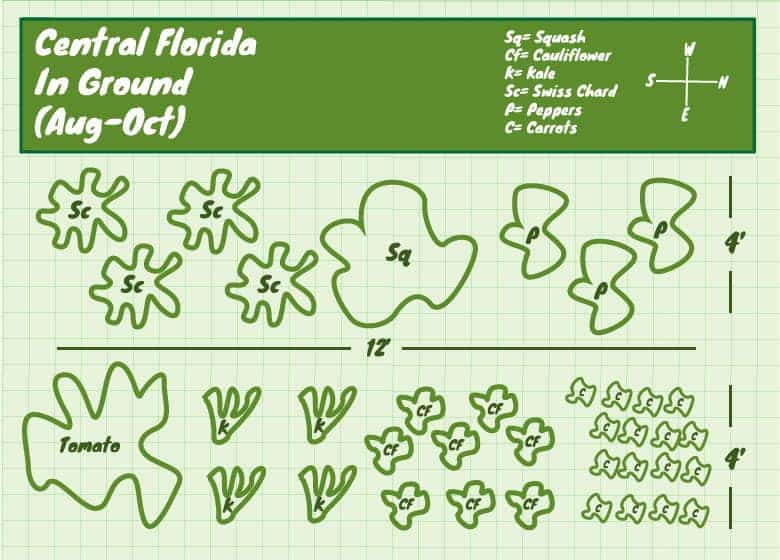
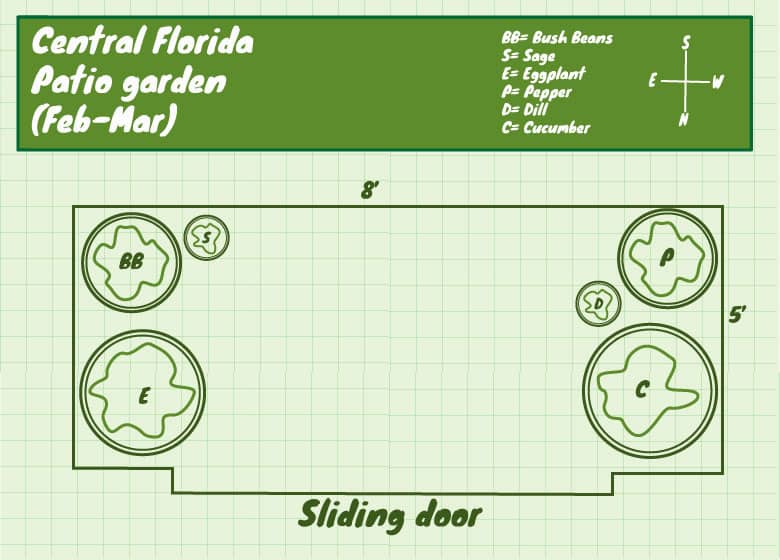
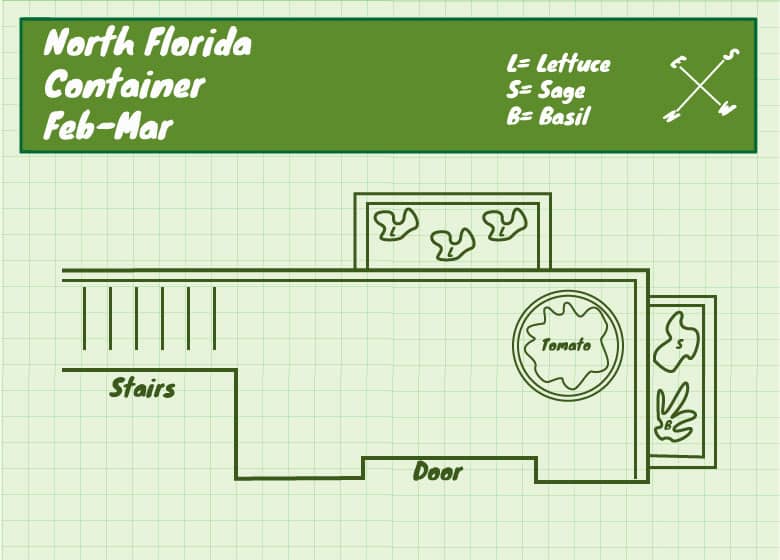
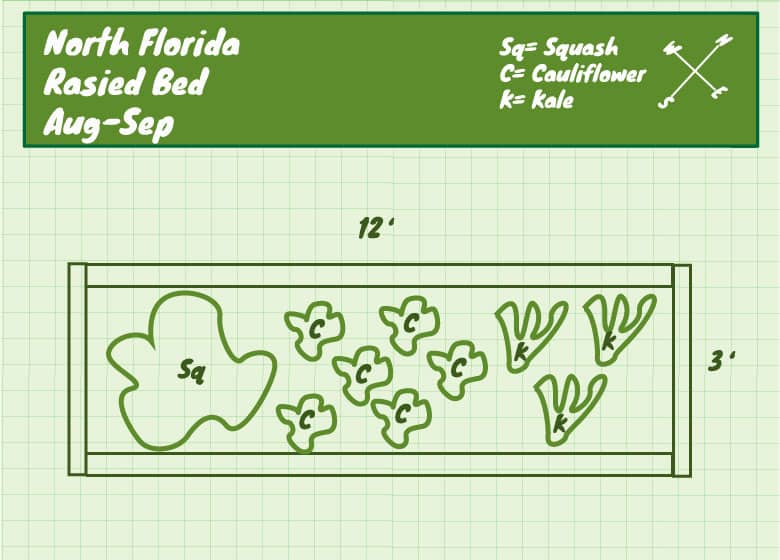
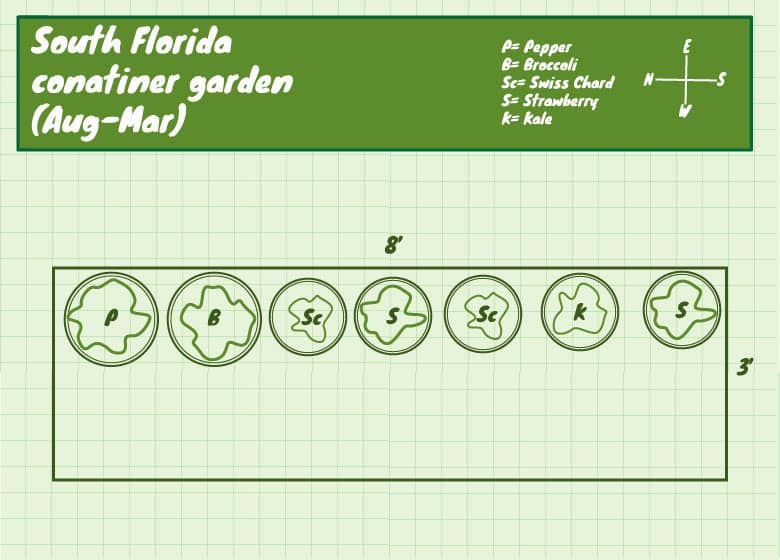
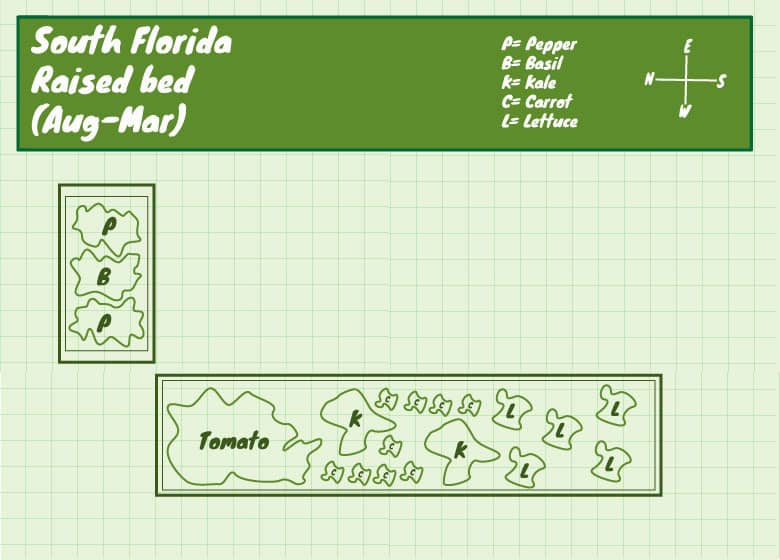
Florida Vegetable Garden Layouts
- Pay attention to the sun, You need 8 hours of good sun for a productive veggie garden
- Gardens oriented from north to south usually get more even sun exposure
- Plan in layers
- Work with harvest times for a more productive garden
- Plan it out on paper with a simple sketch
- Be realistic with the amount of space you are working with
- plant Florida friendly varieties
